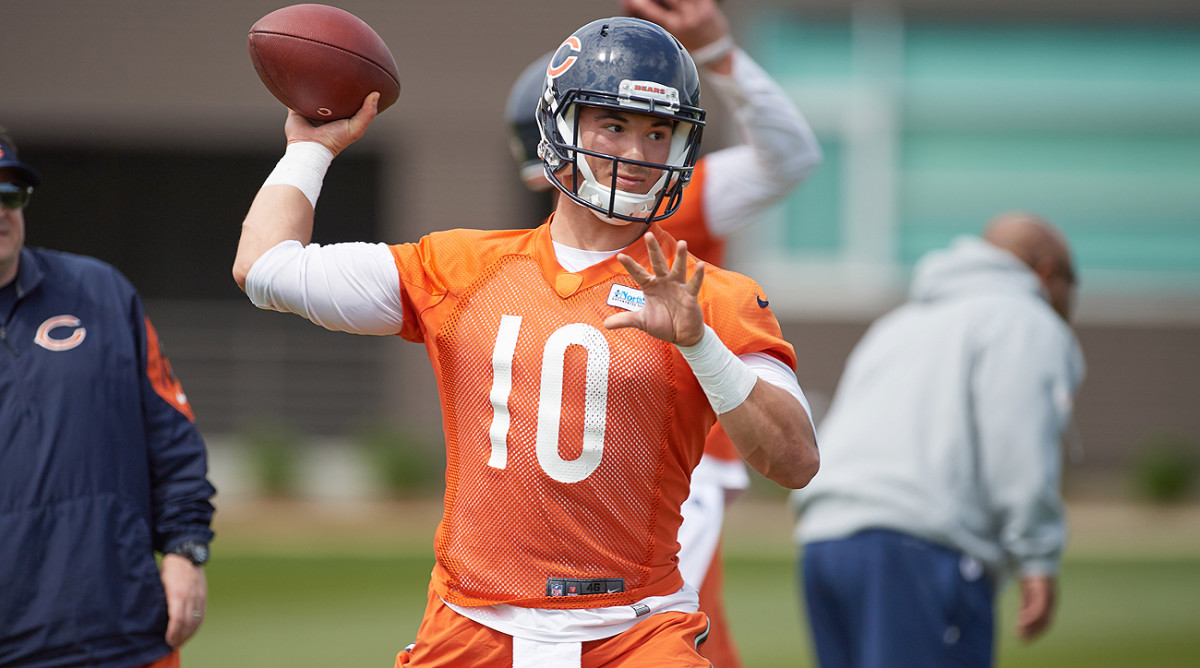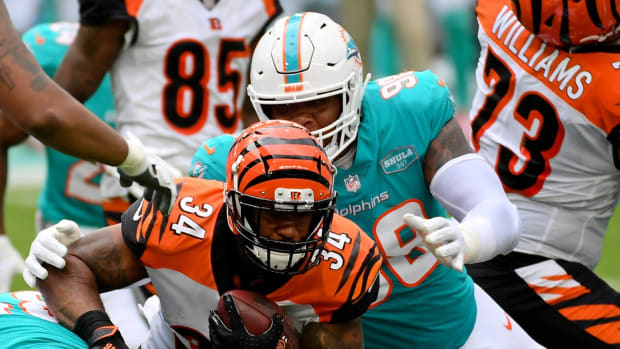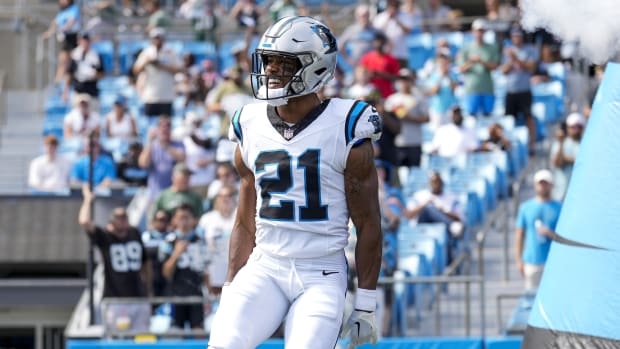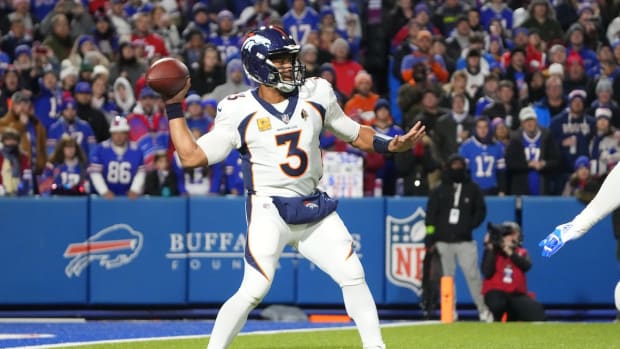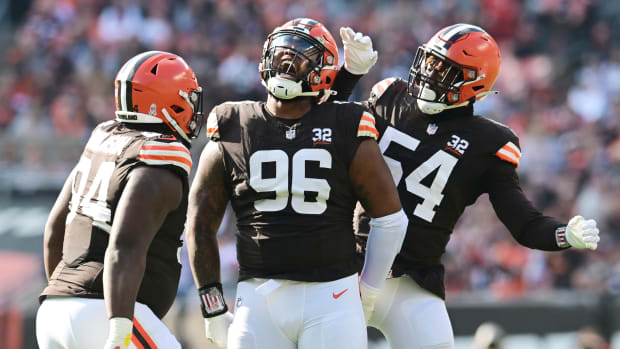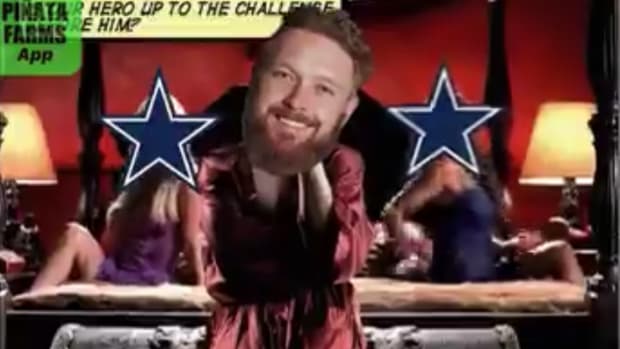Off-Season Report Cards: NFC North
CHICAGO BEARS
2016: 3-13, 4th in NFC North.
Significant Additions: QB Mike Glennon (FA), QB Mitchell Trubisky (R1), CB Prince Amukamara (FA), WR Markus Wheaton (FA), TE Dion Sims (FA), WR Kendall Wright (FA), S Quintin Demps (FA)
Significant Losses: WR Alshon Jeffery, QB Jay Cutler, DB Tracy Porter, WR Eddie Royal, QB Brian Hoyer, DL Cornelius Washington
From the moment the details of Mike Glennon’s contract with the Bears were released, it became clear that he was the starting quarterback of the moment and not of the future.
At first there were audible gasps across the NFL at the three-year, $45 million deal for the guy who has been a backup the past two years. But in reality, that three-year deal could easily be a one-year, $18.5 million deal that allows the Bears to have a serviceable quarterback for a season at the market rate before cutting bait in 2018.
So in April when the Bears traded up one spot for Mitchell Trubisky, it was evident that Trubisky was the starting quarterback of the future. A top pick may not start the first game of his rookie season (hello, Jared Goff), but he has to be the guy no later than the start of Year 2.
The greatest concern facing the Bears going into the offseason—and there were many—was clearly how the Bears would move on from Jay Cutler. They were active in free agency to get one of the best available quarterbacks in Glennon and were aggressive on draft night to get their top quarterback in Trubisky.
Chicago did the best it could to plug that hole, but now a new issue has cropped up: what the hell happens at that position this summer? Trubisky, the rookie who drives his grandmother’s 1997 Toyota to the facility, knew his place immediately.
“Mike is the starting quarterback and I’m very excited to learn from him and the rest of the veterans on the team,” Trubisky told reporters. “And I can’t wait to help the Bears win.”
Trubisky can learn from Glennon, but he can’t learn how to be a starter in the NFL without first-team reps. How can the Bears balance the practice reps Glennon needs to be functionally good with the offense against the reps Trubisky needs if he’s going to learn how to be the guy this year?
Ryan Pace’s legacy as a general manager and the rest of John Fox’s time in Chicago as head coach is hitched to the rookie quarterback, so Trubisky needs to get on the field. Trubisky playing with the second-team offense will help, but only to a point since a rookie needs to know the speed of the NFL game with first-team players.
“That’s going to be something that this organization is embracing,” Bears offensive coordinator Dowell Loggains told reporters, referring to the rep balance between the quarterbacks. “Obviously the two bosses (Pace and Fox) communicate very well with each other, and obviously I’m a part of that.
“…Everyone that touches the schedule is a part of that. So we’ve got to be really good at assessing where each guy’s at, and I think that’s the biggest key for us: knowing exactly where each guy is at and figuring out and being flexible with reps.”
The Bears have a lot to figure out heading into 2017. Can their defensive backfield get more than the NFL-low 11 takeaways from 2016? Will wide receiver Kevin White, in his first full healthy season, take over Alshon Jeffery’s production along with free-agent pickups Dion Sims and Kendall Wright?
But paramount to all is getting Trubisky prepared for the future while putting the best QB on the field on Sundays, and that may very well be Glennon this year. That balance will be tough to strike.
Grade: B
* * *
DETROIT LIONS
2016: 9-7, 2nd in NFC North. Lost in Wild-Card Round.
Significant Additions: G T.J. Lang (FA), LB Paul Worrilow (FA), LB Jarrad Davis (R1), DE Cornelius Washington (FA), CB DJ Hayden (FA), RT Rick Wagner (FA), DT Akeem Spence (FA).
Significant Losses: LB DeAndre Levy, WR Anquan Boldin, G Larry Warford, T Riley Reiff.
Even though the Lions mustered just six points against Seattle in their wild-card loss, the preceding month of football had shown Detroit’s biggest need was on defense.
Things seemed like they finally clicked for quarterback Matt Stafford, and heading into mid-December he was a dark horse in the MVP race for posting another 4,000-yard season in his first without Calvin Johnson. But the defense began failing Detroit in Week 15 and never recovered.
That’s why Lions GM Bob Quinn was so aggressive this offseason in strengthening the D. He had to spend good money to replace offensive linemen Larry Warford and Riley Reiff with T.J. Lang and Rick Wagner, but that had to be done to protect their franchise quarterback. Almost everything else this offseason in Detroit has been geared toward building a defense that will give the Lions a chance in the winter months.
The Lions closed out last season with games against the Giants, Cowboys and Packers before drawing Seattle in the playoffs. In those four games, the defense allowed 377.5 yards and 29 points per game. The Lions had zero interceptions and zero fumble recoveries. They finished the season winless in their last four contests.
Quinn started free agency by getting young pass-rusher Cornelius Washington, who thrived in his limited snaps in Chicago and appeared to be getting the hang of his position by 2016. The Lions also nabbed former Bucs defensive tackle Akeem Spence to add depth behind 11-year vet Haloti Ngata.
Detroit also signed outside linebacker Paul Worrilow, who had gotten edged out in Atlanta by younger players. Former Oakland cornerback D.J. Hayden also signed with Detroit to play opposite Darius Slay.
But there still remained a glaring hole in Detroit’s defense. Long-time linebacker DeAndre Levy got his walking papers this offseason after struggling to stay healthy and perform on his 2015 contract extension. Levy appeared in just four games for the Lions in his final two seasons.
So with the 21st pick in the draft, Detroit took the second-best inside linebacker (behind medical- and red-flag stud Reuben Foster) in Florida’s Jarrad Davis, and Quinn said immediately that Davis would be the team’s middle linebacker. Then Detroit doubled down on Gators and got cornerback Teez Tabor to compete with Hayden in training camp.
Quinn told media before the draft that he saw needs on both sides of the ball, but that’s not how his draft played out. Six of the nine picks are on the defensive side, including three of the first four selections.
“Some of the moves we made on the offensive line may take one position off the board early in the draft. Other than the offensive line, we’re open to adding prospects and adding players to help us,” Quinn said. “Ideally once you get the team exactly how you want—we’re not exactly how we want it right now—we’re working toward that.”
A convincing argument could be made that 2016 was Stafford’s greatest year as a pro, besting his 2011 season when he eclipsed 5,000 yards and threw 41 touchdowns in the 10-win season. Stafford got the Lions into the playoffs without Johnson and engineered eight fourth-quarter, game-winning drives, tied for the most in a season all-time.
If Stafford can repeat that magic in 2017, the Lions have added to a defense that failed them down the stretch and are building the same type of strong, young and fast defense that has made an appearance in recent Super Bowls (Carolina, Atlanta, Denver and Seattle).
The upgrades on defense should allow Detroit to get over the hump of ordinary team hanging on in the playoffs to one that can actually get its first postseason victory in more than a quarter-century.
Grade: A
* * *
GREEN BAY PACKERS
2016: 10-6, 1st in NFC North. Lost in NFC Championship Game.
Significant Additions: TE Martellus Bennett (FA), CB Kevin King (R2), DL Ricky Jean-Francois (FA), G Jahri Evans (FA).
Significant Losses: TE Jared Cook, G T.J. Lang, OL JC Tretter, LB Julius Peppers, RB James Starks, RB Eddie Lacy, CB Sam Shields.
The last time we saw Aaron Rodgers on the field he was trying, and failing, to will his Green Bay Packers to victory against a young and fast Atlanta defense.
The Falcons extinguished Green Bay’s running game and plowed through the Packers’ injured offensive line to pressure Rodgers on nearly half of his dropbacks in the 44-21 NFC championship win against Green Bay.
The Packers have gone to the playoffs in each season since 2009, Rodgers’ second as a starter, and that likely will continue in 2017. They have the best thrower of the football in the game today—and possibly in NFL history—and paired with one of the best football minds in Mike McCarthy, it‘s implausible to think Green Bay won’t be playing in January.
But the two areas that plagued the Packers in the Georgia Dome and kept them from their second Super Bowl appearance with Rodgers and McCarthy were addressed in less-than-satisfactory ways this offseason.
Eddie Lacy opted for Seattle over Green Bay, and the Packers released James Starks and then re-signed, then cut, Christine Michael. That left in the backfield only Ty Montgomery, who was a fun story in 2016 as the No. 88 wideout filling in as the starting running back.
McCarthy affirmed Montgomery will be the starter heading into training camp, but the third-year player will have to produce more if Rodgers is to get a reliable running game. Montgomery topped 50 rushing yards in just three games last season and had 100 total yards in the same amount of games. (Montgomery was the leading Packers rusher in the NFC title game not named Rodgers with three carries for 17 yards.) Surely an offseason focused on the position will help Montgomery, but will it be enough?
Green Bay spent the final day of the draft taking every running back in sight. The Packers used a fourth-rounder on BYU’s Jamaal Williams, a compensatory pick on UTEP’s Aaron Jones and their last pick on Utah State’s Devante Mays. Those additions add good numbers on a depth chart, but the reality remains the NFC North kings have a converted wide receiver and slew of third-day rookies toting the rock to open up Rodgers’ passing game.
But more important than who is running for Rodgers is who is blocking for him. In consecutive seasons the Packers have done away with one of Rodgers’ offensive linemen, and there’s dubious depth at a position group so vital to what the two-time MVP does.
First came the Packers releasing guard Josh Sitton at the start of the 2016 season just to see him end up on rival Chicago’s roster. Then Green Bay didn’t bring back guard T.J. Lang this offseason, instead seeing him sign with another divisional rival—Detroit. Green Bay also didn’t re-sign (the sometimes-injured) center JC Tretter, and he went to Cleveland for big money. This comes months after Green Bay’s offensive line was in such dire straits against Atlanta that defensive tackle Letroy Guion had to play five snaps along the line in the fourth quarter.
A quality offensive line for the Packers is important for two reasons: Rodgers holds the ball longer than almost every quarterback in the league, and replacing him with backup Brett Hundley (in the event Rodgers takes a hit due to poor blocking) will no doubt keep Green Bay out of the playoffs.
“It took a while,” Lang told SI.com in January about learning to block for Rodgers on long-developing plays. “We understand there’s times we need to extend the play. Our guys aren’t open and Aaron needs us. We’re used to it, we will block however long it takes, you just need to stay in front of your guy.”
David Bakhtiari and Bryan Bulaga make up one of the best tackle duos in the league, and Lane Taylor played decently in place of Sitton at left guard last year. Don Barclay, who struggled, and Jahri Evans, who will be 34, should compete for the other guard spot, and the Packers used just one draft pick on an offensive lineman when they took guard Kofi Amichia in the sixth round.
Rodgers will still be great with Jordy Nelson and Randall Cobb to throw to, and getting Martellus Bennett will make it even tougher to outscore the Pack in 2017. But the cohesiveness of the line and competence of the backfield will determine whether Green Bay can once again, finally, get back to the Super Bowl.
Grade: B
* * *
MINNESOTA VIKINGS
2016: 8-8, 3rd in NFC North.
Significant Additions: RB Latavius Murray (FA), RB Dalvin Cook (R2), RT Mike Remmers (FA), WR Michael Floyd (FA), QB Case Keenum (FA), DE Datone Jones (FA), T Riley Reiff (FA)
Significant Losses: RB Adrian Peterson, CB Captain Munnerlyn, LT Matt Kalil, WR Cordarrelle Paterson, T Andre Smith, WR Charles Johnson
There was always a hope when it came to Adrian Peterson in Minnesota.
When he tore his ACL and MCL at the end of 2011, there was a hope that he would regenerate and return to form. (He did.) In 2014 when he was placed on the commissioner’s exempt list for child abuse charges, the hope was that he’d return late in the season and rescue the Vikings. (He didn’t.) Even last year, at age 31, he tore the meniscus in his right knee and had surgery immediately with the thought that he could come back and lead a big December push to get the Vikings into the playoffs. (He didn’t do that, either.)
There is no more hope for Peterson in Minnesota after the Vikings didn’t exercise his option and he signed with New Orleans in April. The long-time cornerstone of the franchise and the greatest running back of the past decade is gone, but his position should be just as important to the Vikings as it has been in recent years.
Minnesota loaded up at running back after Peterson’s departure. The Vikings kept Jerick McKinnon, who led the team in rushing in 2016 with 539 yards, and they added Latavius Murray in free agency and Dalvin Cook in the draft.
The biggest question facing the Vikings is when will Teddy Bridgewater return to full health, if ever, after that devastating knee injury last preseason. That question likely was answered when the Vikings didn’t pick up his fifth-year option; Sam Bradford will be the starter to begin the season, and possibly throughout the year. So the next biggest question is who is the starting running back between Murray and Cook.
“We’ve got a long, long way to go before we make any determinations on that,” Minnesota coach Mike Zimmer told reporters recently.
McKinnon was forced into the starting role last season, but there’s no mistake that the job will go to either Murray or Cook. The Vikings signed Murray to a three-year deal—which they can escape after one season—after Oakland let him walk in free agency. Murray had more than 1,800 rushing yards in the past two seasons along with 18 rushing touchdowns while being one of the best pass-blocking backs in the game.
But Murray had ankle surgery less than a week after signing with the team and will miss all of the on-field work leading up to training camp. That opens the door for the rookie Cook to establish himself before the Vikings head to Mankato in late July.
Cook was a consistently great runner at Florida State where he made home-run plays with his shiftiness. His off-field concerns in the pre-draft process shouldn’t affect his on-field play, but his previous injuries and lack of athleticism could. Cook has dealt with shoulder and hamstring injuries since college, and he performed poorly in the athletic testing at the combine. For those reasons, the third-best running back in the draft had to wait until the second day to be selected.
But Minnesota didn’t want to wait too long on Cook. Sitting at No. 48, the Vikings traded with the Bengals to move to No. 41 and get Cook.
The hope is that with two quality running backs, Minnesota’s offensive line will look better than it did last year. Marred by injuries, the Vikings’ line doomed them after a 5-0 start. In turn, Bradford regressed and Minnesota had just two 100-yard rushing games all season long.
General manager Rick Spielman got two run-blocking tackles in Riley Reiff and Mike Remmers in the offseason—a sign that the Vikings, with no star power at wideout, will maintain their run-heavy ways.
Peterson is gone, and it’s probable that no one will ever wear No. 28 for Minnesota again. But if the goal is to get 1,500 rushing yards from your top back, that can be achieved by combining Murray and Cook in the backfield in 2017.
Grade: B
• Question or comment? Email us at talkback@themmqb.com.
































